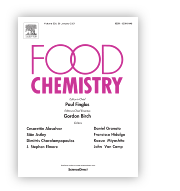Exploring fruits from genus Prunus as a source of potential pharmaceutical agents – In vitro and in silico study
Boris M. Popović, Bojana Blagojević, Alicja Kucharska, Dejan Agić, Nenad Magazin, Maja Milović, Ana Teresa Serra
Food Chemistry
 Prunus fruits are recognized to be rich sources of polyphenols with health promoting effect. In this work we evaluated the phenolic profile and bioactivity, namely antioxidant capacity, antiproliferative effect in HT29, and inhibition capacity of α-glucosidase (α-Gls), α-amylase (α-Amy) and human dipeptidyl peptidase III (hDPP III) activities, of traditional Prunus fruits grown in Serbia. Fifteen Prunus samples were investigated and compared: common European plum and three old plum subspecies (‘vlaškača’, damson plum and white damson), purple-leaf cherry plum, red and white cherry plum, sweet cherry, sweet cherry-wild type, sour cherry, steppe cherry, mahaleb cherry, blackthorn, peach, and apricot. Principal Component Analysis highlighted steppe cherry and blackthorn as Prunus species with the highest bioactive potential. In silico analysis pointed out rutinoside derivatives of cyanidin and quercetin as the most potent inhibitors of α-Gls, α-Amy and hDPP III enzymes. Quercetin 3-O-rutinoside showed the highest binding energy to α-Gls (−10.6 kcal/mol).
Prunus fruits are recognized to be rich sources of polyphenols with health promoting effect. In this work we evaluated the phenolic profile and bioactivity, namely antioxidant capacity, antiproliferative effect in HT29, and inhibition capacity of α-glucosidase (α-Gls), α-amylase (α-Amy) and human dipeptidyl peptidase III (hDPP III) activities, of traditional Prunus fruits grown in Serbia. Fifteen Prunus samples were investigated and compared: common European plum and three old plum subspecies (‘vlaškača’, damson plum and white damson), purple-leaf cherry plum, red and white cherry plum, sweet cherry, sweet cherry-wild type, sour cherry, steppe cherry, mahaleb cherry, blackthorn, peach, and apricot. Principal Component Analysis highlighted steppe cherry and blackthorn as Prunus species with the highest bioactive potential. In silico analysis pointed out rutinoside derivatives of cyanidin and quercetin as the most potent inhibitors of α-Gls, α-Amy and hDPP III enzymes. Quercetin 3-O-rutinoside showed the highest binding energy to α-Gls (−10.6 kcal/mol).
10.1016/j.foodchem.2021.129812
The water-holding capacity of meat: A reference analytical method
Tadeusz Szmańko, Tomasz Lesiów, Justyna Górecka
Food Chemistry
 The water-holding capacity (WHC) of meat affects its characteristics and is a crucial criterion for assessing meat quality. However, there is no precise analytical method for determining meat WHC. This study aimed to develop a precise and widely applicable method to determine the WHC of turkey and pork samples. A filter-paper press method was used to present WHC as water content (%) before and after pressing (WHC1) or water content (%) after pressing relative to the fat-free dry matter components of the tested meat (WHC3). In cases where pressing released both fat and muscle juice, procedures to calculate WHC2 or WHC4 were applied. This increased the precision of WHC values calculated using formulas 1 and 3 (for WHC1 and WHC3 values, respectively). Expressing WHC as WHC3 ensured absolute precision in determining WHC. This study successfully developed a reference analytical method for accurately determining meat WHC.
The water-holding capacity (WHC) of meat affects its characteristics and is a crucial criterion for assessing meat quality. However, there is no precise analytical method for determining meat WHC. This study aimed to develop a precise and widely applicable method to determine the WHC of turkey and pork samples. A filter-paper press method was used to present WHC as water content (%) before and after pressing (WHC1) or water content (%) after pressing relative to the fat-free dry matter components of the tested meat (WHC3). In cases where pressing released both fat and muscle juice, procedures to calculate WHC2 or WHC4 were applied. This increased the precision of WHC values calculated using formulas 1 and 3 (for WHC1 and WHC3 values, respectively). Expressing WHC as WHC3 ensured absolute precision in determining WHC. This study successfully developed a reference analytical method for accurately determining meat WHC.
10.1016/j.foodchem.2021.129727









